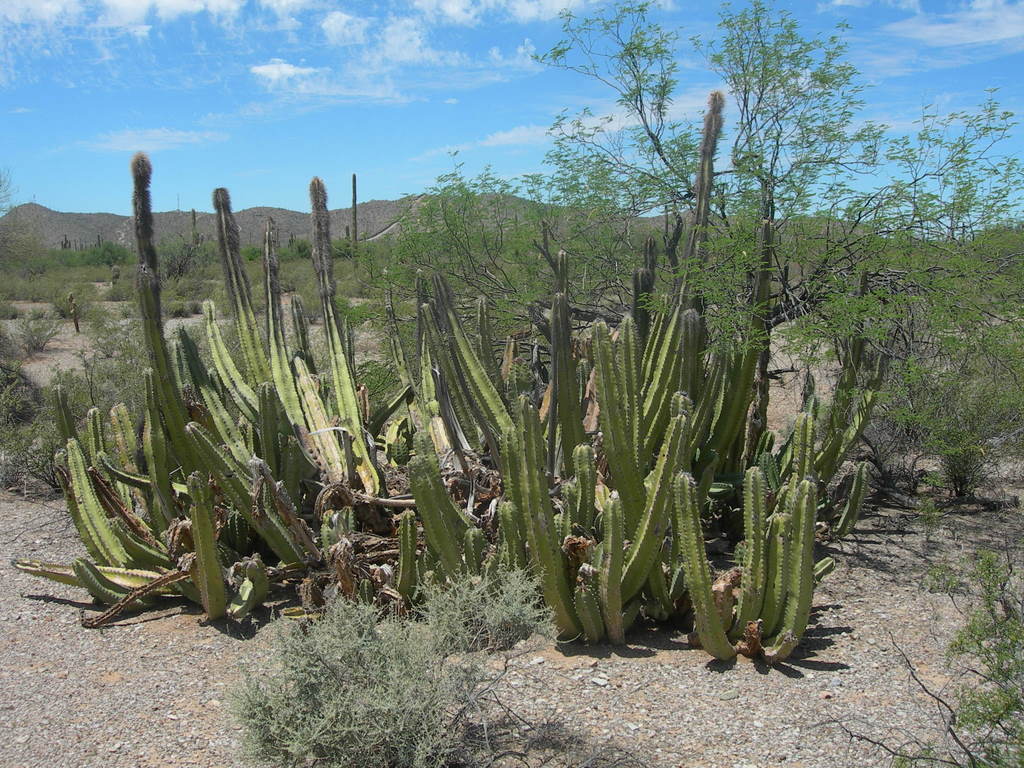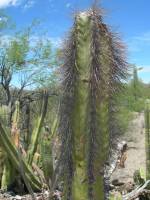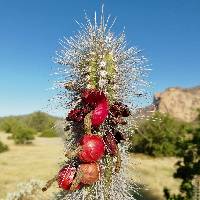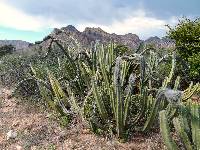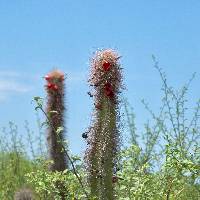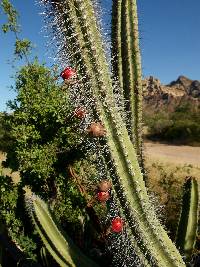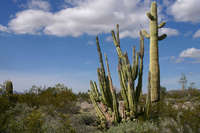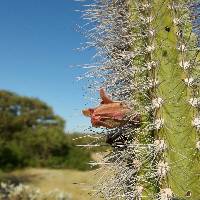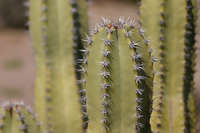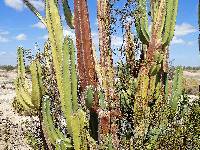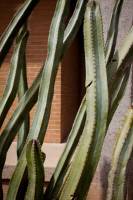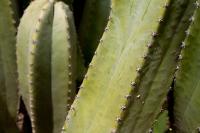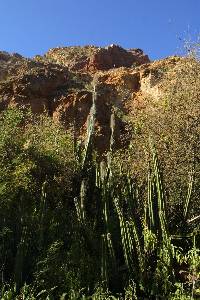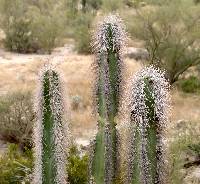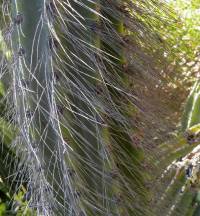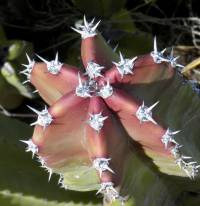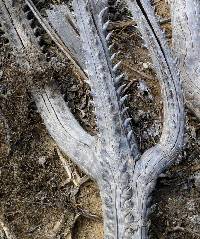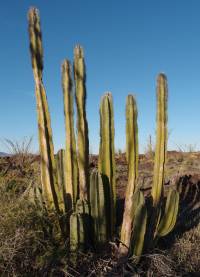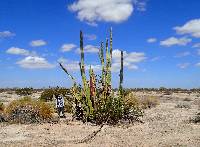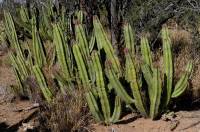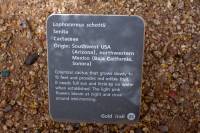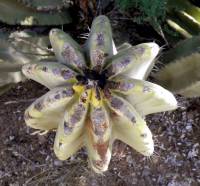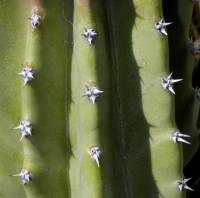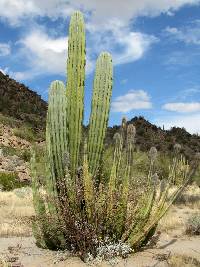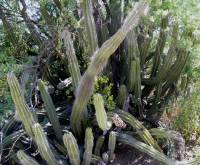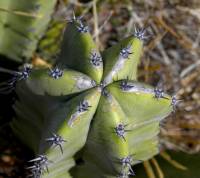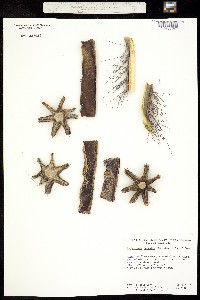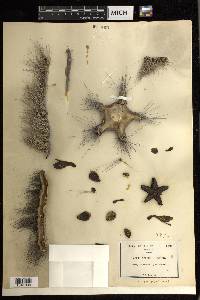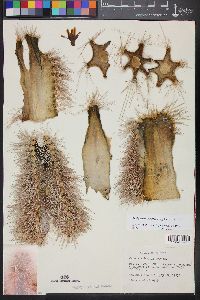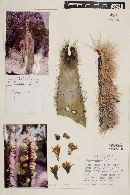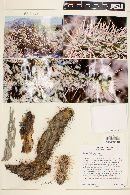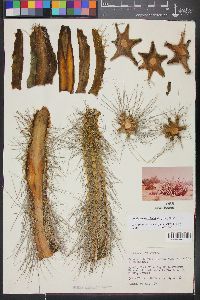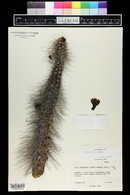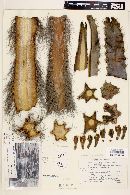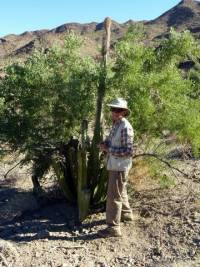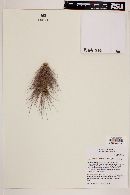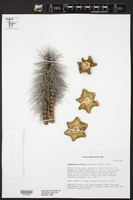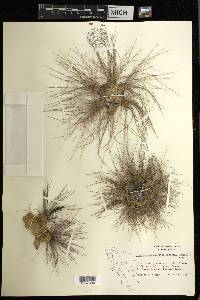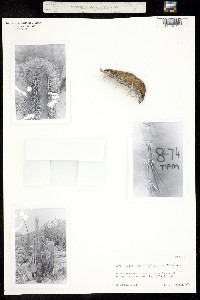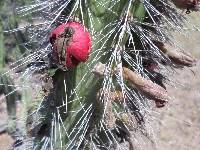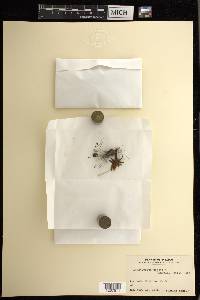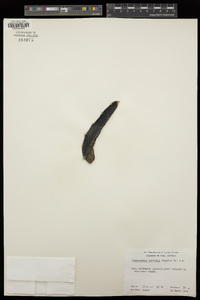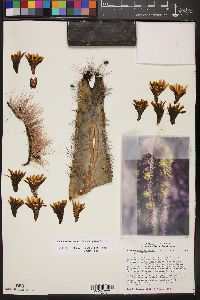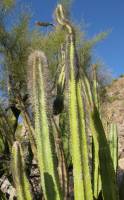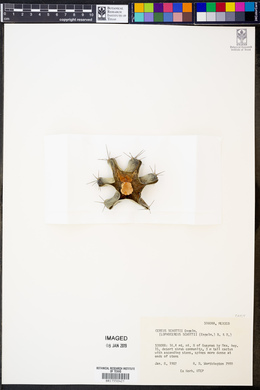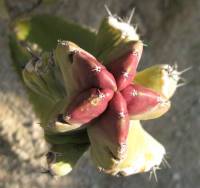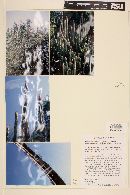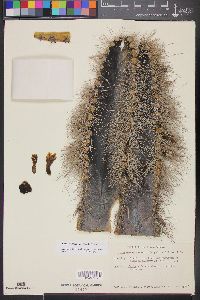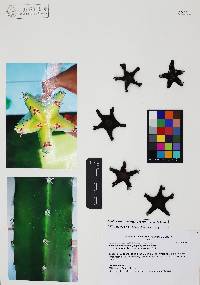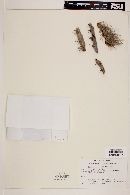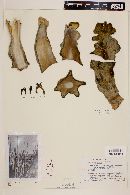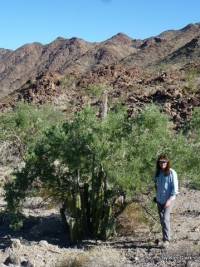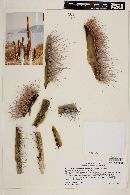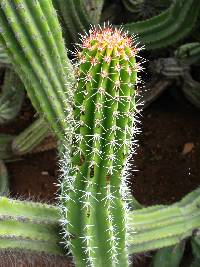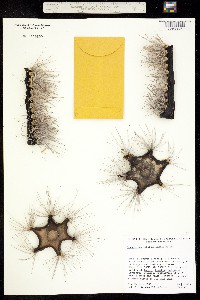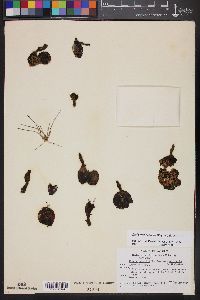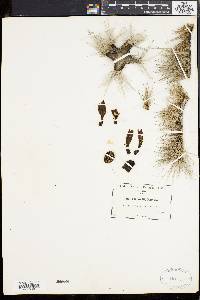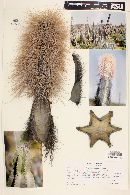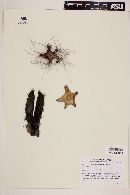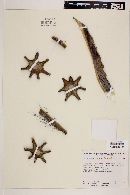
|
|
|
|
Family: Cactaceae
Senita, more...senita cactus, senita (es: sinita, senita, cabeza de viejo, garambullo, tuna (pitahaya) barbona, hombre viejo, músaro)
[Cereus schottii Engelm., moreLophocereus mieckleyanus (Weing.) Backeb., Lophocereus sargentianus (Orcutt) Britton & Rose, Lophocereus schottii (Engelm.) Britt. & Rose, Lophocereus schottii var. tenuis G.E.Linds.] |
Shrubs [to small trees], with basal branches sometimes rooting to form thickets. Stems green with red around young areoles, aging gray-green with faint waxy chevrons; ribs somewhat rounded, margins relatively flat; areoles 1-1.5 cm apart on rib crest, shield-shaped, on proximal stems 1 cm wide, those on distal stems closer together, circular; young hairs whitish gray, short. Spines strongly dimorphic, those on proximal stems usually 7-10 per areole, rose-red, aging gray, stout, usually 5-7 mm, to less than 30 mm, weakly differentiated as central and radial spines, those on distal stems usually more than 15 per areole, gray to blackish (rarely aging copper-brown), thin, flattened, twisted, to 7.5 cm; bristles 4-10 cm. Flowers lateral on stems, often several per areole, on specialized bristle-forming or transition areoles, short funnelform, 3-4.5 × 2-3 cm; flower tube thin walled, very narrow, less than 1.5 cm; nectar chamber open; scales rose with green margins; tepals spreading, reflexed by morning; outer tepals somewhat fimbriate, minutely papillate; inner tepals 25, with pink-orange center, 11-16 mm, apex acute; stamens 100, white, turning pink by next morning, to 2 cm; anthers cream; ovary small, tubercles and spines absent; styles white, short, narrow; stigma lobes erect, relatively short. Fruits candy-apple red, when immature greenish, ovoid to subspheric, 25-40 mm. Seeds helmet-shaped, often with a prominent raphe. 2n = 22. Flowering late Mar-Sep[-Dec]; fruiting often 1 month after flowering. Cercidium-Larrea-Olneya-Carnegiea communities, around washes, on sandy [gravelly] soils; 400-500 m; Ariz.; Mexico (Baja California, Baja California Sur, Sinaloa, Sonora). Pachycereus schottii is primarily a Mexican species occuring in southernmost Arizona only in Organ Pipe Cactus National Monument at nine sites very close to the international boundary, where winter temperatures do not generally reach freezing. The Arizona populations do not appear to be experiencing much recruitment via seeds, but persist by vegetative propagation. In Mexico, plant height, rib number, and rib shape vary considerably with microhabitat. In subtropical thorn forest P. schottii may be a small tree with a very short trunk. Three varieties of P. schottii were formally recognized (G. S. Lindsay 1963) but need to be re-examined using DNA techniques. If varieties or subspecies are accepted, Arizona populations would represent the typical form. In contrast to other species of Pachycereus, P. schottii and its narrowly restricted cousin P. gatesii of Baja California Sur, Mexico have the smallest flowers and seeds and the most fleshy and naked fruits. The flowering portion of each adult stem always has long, grayish bristles, inspiring the anthropomorphic vernacular names referring to old age. The moth Upiga virescens (Pyralidae) is the obligate pollinator of Pachycereus schottii, forming a mutualistic system comparable with the yucca and yucca moth (J. N. Holland and T. H. Fleming 1999, 1999b; R. S. Felger and A. D. Zimmerman 2000). In populations near the inter-national border, flowers of P. schottii open ten minutes after sunset (J. N. Holland, pers. comm.).
Plant: Shrubs to 6.5 m tall. STEM branches erect, green, aging grayish with faint, waxy chevrons, 10-20 cm in diameter; ribs (in ours) 5-6(-7), to 3.5 cm high, longitudinally continuous. AREOLES circular to broadly elliptic, to 13 mm long, yellow- to tan-woolly, to ca. 2 cm apart on rib to nearly contiguous on rib apices Leaves: SPINES of lower areoles reddish, turning brown or gray to blackish, angular-subulate, to 22 mm long, bulbous-based; spines of middle areoles transitional, or those of upper areoles usually to tan or reddish aging gray, ca. 25-50+ per areole, up to 7.5(-11) cm long, weak, flattened, twisted Flowers: 2.5-4 cm long, 2-4 cm in diameter; floral tube scaly, to 2.5 cm long; outer tepals dark with pale margins; inner tepals whitish to deep pink, oblanceolate, obtuse, to 1.5 cm long; stamen filaments white, the anthers yellow; style and stigma lobes white Fruit: FRUITS few-scaled, spineless, splitting irregularly, pulp sour. SEEDS glossy, tessellate polygonal cells, 2-2.3 mm long, 1.8--2.2 mm wide Misc: Sonoran Desert, flats, washes and low hills on sand, lava and granitic substrates; 350-500 m (1200-1700 ft); May-Jun REFERENCES: inkava, Donald J. 1995. Cactaceae. J. Ariz. - Nev. Acad. Sci. 29(1): 2, 6. FNA 2004, Pinkava 1995, Benson 1969 Common Name: senita cactus Duration: Perennial General: Columnar shrubs with erect stems that form thickets with much branching basally, the stems to 6.5 m tall, ribs rounded with flat margins to 3.5 cm high, longitudinally continuous, the stems green with red around young areoles and aging gray green with faint, waxy chevrons, 10-20 cm in diameter. Spines: Areoles broadly elliptic or circular, 1-1.5 cm apart on rib crest, to 13 cm long, yellow to tan woolly, lower spines reddish turning brown to gray or blackish, to 22 mm long, bulbous based, upper spines tan to reddish but aging gray with 25-50 per areole, flattened and twisted, appearing shaggy on upper stems with age. Flowers: Nocturnal and lateral on stems with several per areole, usually on middle or transitional areoles, short funnel form 2.5-4 cm long 2-4 cm in diameter, the floral tube scaly and rose colored, the tepals spreading to being reflexed in morning, with pink-orange center, the stamens white and short. Fruits: Candy apple red at maturity, few scaled and spineless, splitting irregularly, ovoid to subspheric, 2.5-4 cm long. Ecology: Found in flats along washes and on low hills, preferring sandy, lava, or granitic substrates from 1,000-2,000 ft (305-610 m), flowers March-September. Distribution: Found in the warmest parts of the Sonoran Desert in Arizona, then south to Sinaloa, and south on the Baja California. Notes: This species is one of the big cacti that have a beautiful upright thicket, similar in this respect to organ pipe cacti. This species is easily distinguished by virtue of the fuzzy gray appearance of the upper parts of the stems, which gives it the other common name of old man cactus. Ethnobotany: Unknown, but other species in the genera had a number of uses. Etymology: Pachycereus comes from the Greek pachys for thick and the Latin cereus meaning a tapered candle, while schottii is named for Arthur Carl Victor Schott (1814-1875) a naturalist on the Mexican Boundary Survey. Synonyms: Cereus schottii, Lophocereus schottii, Pilocereus schottii Editor: SBuckley, 2011 |
|
|
|
This project was made possible in part by the Institute of Museum and Library Services [MG-70-19-0057-19].
Powered by Symbiota

